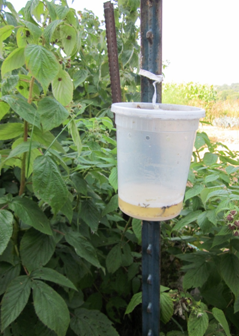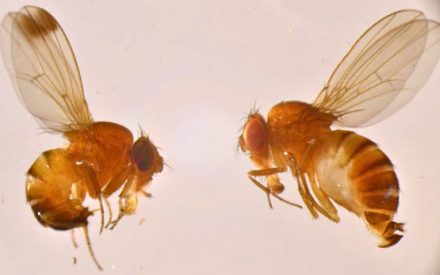Pest Alert

Authors: Janet van Zoeren and Christelle Guédot, UW-Madison Entomology
Last Revised: 04/17/2019
X-number: XHT1267
The African fig fly (AFF), Zaprionus indianus, is an invasive vinegar fly closely related to flies in the genus Drosophila [which includes the common vinegar fly (also sometimes called the common fruit fly) and spotted-wing drosophila (SWD)]. AFF is native to Africa, Eurasia and the Middle East. It was first detected in the United States in Florida in 2005, where it is now well established. In 2012, AFF (a single adult) was first detected in Wisconsin. In 2017, larger numbers of AFF were found in the state in traps used to monitor for SWD.
Outside of Wisconsin, AFF has had its biggest economic impact in commercial fig production, and has not been found to have a significant economic impact on other agricultural crops. In Wisconsin, the potential economic impact of AFF on fruit and other crops is not yet known. Because AFF reproduces readily and can rapidly expand its range, careful monitoring for this insect in the state is warranted.
Appearance: The adult AFF is slightly larger than the common vinegar fly or SWD, and has a light-colored body and bright red eyes. An adult AFF has four black-bordered, white stripes that run along each side of its head and thorax (but not its abdomen). These stripes can easily be seen using a hand lens and are not found on any other vinegar flies in Wisconsin. An AFF larva (maggot) is legless and has a single hook-like tooth at its mouth-end. The maggot uses this tooth to feed on rotted berries and other soft fruit tissues. AFF maggots are nearly indistinguishable from maggots of common vinegar flies and SWD.
Host Range: AFF can feed on a large number of fruit crops grown in Wisconsin, including blackberries, blueberries, grapes, peaches, raspberries and strawberries, with grape being a preferred host.
Symptoms and Effects: Given that AFF is a newcomer to Wisconsin and its temperate climate, predicting which fruits the insect will affect, and to what extent, is difficult. What is known about AFF is that it cannot initiate damage to intact, ripe fruit; it can only feed on and lay eggs inside of overripe or already damaged fruit. The insect contributes to additional breakdown and decay of these fruit. In Wisconsin, AFF and SWD (which can damage intact, ripe fruit) will likely occur together at a given location, and will likely interact. AFF may end up laying eggs in fruit damaged by SWD, possibly leading to an increase in AFF populations. The effects of AFF on SWD populations are not clear at this time. However, some research conducted in grapes suggests that where AFF and SWD occur together, they may compete, leading to increased numbers of AFF and lower numbers of SWD.
Life Cycle: As an insect native to the tropics, AFF will likely not be able to survive even a mild winter in Wisconsin; in fact, AFF does not appear to overwinter even as far north as Virginia. However, AFF can travel long distances on air currents, and could potentially travel from the southern US to Wisconsin in the spring and summer, leading to fruit infestations in the state in the summer and fall. AFF has only been detected in Wisconsin in 2012 and 2017, suggesting that if the insect does cause problems in Wisconsin, these problems will not likely be a yearly occurrence.
Exactly how many generations of AFF might develop in Wisconsin in a given year is not known. In the laboratory (at 75°F), AFF develops from egg to adult in 20 days and females lay, on average, 60 eggs. Based on its short generation time and ability to produce numerous eggs, AFF populations could potentially build quickly within a given year, once the insect arrives in Wisconsin.
Monitoring: Monitor for AFF using the same traps that you would use to monitor for SWD. You can buy commercially available traps, or alternatively, you can make simple, inexpensive traps using a 32-ounce clear plastic container with a lid. To allow adult flies to enter the trap, drill or melt ten 3/16 inch diameter holes around the top of the container. Bait traps with one tablespoon active dry yeast and four tablespoons sugar in twelve ounces of water. Alternatively, use a two-inch layer of apple cider vinegar in the bottom of the container.

Add one to two drops of unscented dish soap to the trap to break the surface tension of the liquid so that flies are more likely to drown. Hang traps in a shaded plant canopy where fruit is present. For strawberries, place traps on the ground. Check traps and replace liquid bait weekly, using a hand lens to identify trapped insects. Be careful not to pour bait on the ground near the traps as this will confuse flies and reduce the effectiveness of the traps. DO NOT bother testing fruit directly to determine infestation rates for AFF, as AFF larvae will be indistinguishable from those of other vinegar flies (e.g., common vinegar fly and SWD).
Control: Because AFF cannot cause damage to sound fruit, and because recorded populations of AFF in Wisconsin have been low, AFF control may not be needed unless/until severe outbreaks occur. Control methods recommended for SWD will likely also help control AFF. In particular, cultural practices such as removing all damaged or rotting fruit and then solarizing (heating) or freezing this material to kill fly larvae may slow buildup of AFF at a given location in a given growing season. However, because AFF is able to move over long distances from areas in the south where it can easily overwinter, reintroduction of the insect will be possible even if you follow strict sanitation practices.
Exclusion netting, which has been used with some success to manage SWD, will likely also help manage AFF. When using netting, use a mesh size that is 1/32 inch or smaller. Start using netting after early fruit set (so as not to interfere with pollination), but before fruit begins to ripen. Make sure the mesh completely covers fruit with no gaps between sheets of netting or at the soil surface. Any opening can provide an entry point for AFF.
Chemical control for AFF is not currently recommended in Wisconsin. Observed AFF populations have not been high enough to warrant such treatments. If spraying for AFF does become necessary, choose insecticides (e.g., spinosyns, carbamates and organophosphates) that also provide control of SWD. As always, rotate active ingredients that are in different IRAC chemical classes (i.e., have different modes of action) to delay development of insecticide resistance. For details on IRAC chemical classes, see https://www.irac-online.org/modes-of-action/. Also, be sure to consider the effects of the products that you select, on non-target insects, particularly beneficial insects such as bees. Please check the most recent Midwest Fruit Pest Management Guide (see https://learningstore.uwex.edu) for full product recommendations.
If you suspect that you have found an AFF, please contact the University of Wisconsin-Madison Insect Diagnostic Lab at (608) 262-6510, idl@entomology.wisc.edu or http://labs.russell.wisc.edu/insectlab/contact-us/.
Download Article





 Spotted Wing Drosophila
Spotted Wing Drosophila Spotted Lanternfly
Spotted Lanternfly Trees and Shrubs for Diversity and Climate Change
Trees and Shrubs for Diversity and Climate Change Apple Pest Management for Home Gardeners
Apple Pest Management for Home Gardeners


